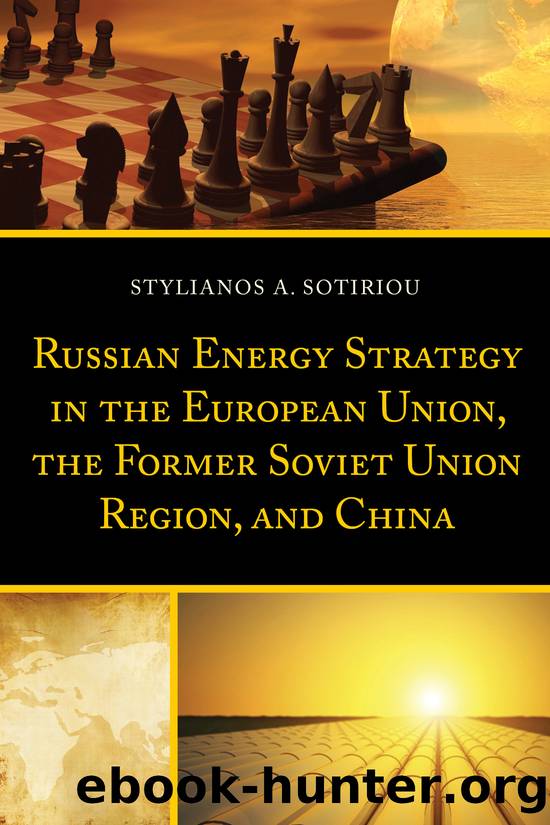Russian Energy Strategy in the European Union, the Former Soviet Union Region, and China by Sotiriou Stylianos A.;

Author:Sotiriou, Stylianos A.;
Language: eng
Format: epub
Publisher: Lexington Books/Fortress Academic
Chapter 5
The Strategic Russia-EU Energy Relations
Until When?
5.1 Understanding interdependence
5.1.1 The Rise of the Natural Gas Era in Europe
Before entering the core of modern gas business between Russia and the EU, it would greatly benefit our understanding to take a brief look at the recent history of natural gas in a rapidly changing Europe.
The debut of natural gas in Western Europe occurred in 1959 with the coming into light of the Dutch gas field âGroningenâ (Stern, 2003; IEA, 2009, p. 420). Following that, major discoveries were made in UKâs sector of the North Sea and off the Norwegian coast, with the latter having so abundant resources that they could cover not only the Norwegian needs but also be exported via newly built pipelines to the Continental Europe and the UK (Stern, 2003).1 However, the need for external supply sources was not to be underestimated. Small quantities of Soviet gas had been steadily exported to Poland since the late 1940s, while the upgrading to large-scale gas exports was accomplished no sooner than the huge gas deposit Shebelinka had reached culmination in 1975 and the Soviet production shifted to the Siberian fields âMedvezhe,â âUrengoyâ and âYamburg,â thereafter (Stern, 2003).2,3 These developments were accompanied also by the construction of a multiple-string natural gas network aimed at connecting the aforementioned gas fields with Western Europe via Ukraine (Stern, 2003).4 In parallel, new ties were forged with other regions as well.
The Trans-Mediterranean gas network (from Algeria to Sicily via Tunisia) was laid down in 1983, connecting Northern Africa with the South EU, while with more than a decade delay, another gas network, the GME, focusing on the same geography but on the opposite direction, connected Algeria with Spain and Portugal via Morocco (Stern, 2003).
Consequently, in the broader picture of first the Western Europe and later the EU natural gas supplies, traditionally, there have been three large exporters: Norway, Russia and Algeria. Two of them, Norway and Algeria, have been partly supplying different regions of the EU. Norwegian gas supplies have been earmarked for the UK and Northwest Continental Europe while Algerian supplies have been earmarked for the Iberian Peninsula and Italy. The third, Russia, has been the main supplier, filling the needs across the EU in the continental northern, central and southern gas markets (Clingendael, 2008).
The primacy of Russia, however, in the EU gas balance during the 2000s and the strategic implications sprouting out of this situation trace their roots back in the 1980s, when a handful of the then EC âpillarâ states, namely France, Germany and Italy, decided to deepen its cooperation with the Soviet Union by consenting to long-term âtake-or-payâ contracts for more gas and to the extension of the Unified Gas System into Europe (Clingendael, 2008, p. 20).5 This âcold warâ geoeconomic intimacy was growing so rapidly that it added much to the fears of the then American administration that the Soviets had found a way to maneuver geopolitically at the expense of the West.6
After the collapse of the Soviet Union, Russia dominated
Download
This site does not store any files on its server. We only index and link to content provided by other sites. Please contact the content providers to delete copyright contents if any and email us, we'll remove relevant links or contents immediately.
| Arms Control | Diplomacy |
| Security | Trades & Tariffs |
| Treaties | African |
| Asian | Australian & Oceanian |
| Canadian | Caribbean & Latin American |
| European | Middle Eastern |
| Russian & Former Soviet Union |
The Secret History by Donna Tartt(18792)
The Social Justice Warrior Handbook by Lisa De Pasquale(12103)
Thirteen Reasons Why by Jay Asher(8761)
This Is How You Lose Her by Junot Diaz(6729)
Weapons of Math Destruction by Cathy O'Neil(6102)
Zero to One by Peter Thiel(5652)
Beartown by Fredrik Backman(5566)
The Myth of the Strong Leader by Archie Brown(5391)
The Fire Next Time by James Baldwin(5217)
How Democracies Die by Steven Levitsky & Daniel Ziblatt(5105)
Promise Me, Dad by Joe Biden(5054)
Stone's Rules by Roger Stone(5003)
100 Deadly Skills by Clint Emerson(4816)
A Higher Loyalty: Truth, Lies, and Leadership by James Comey(4813)
Rise and Kill First by Ronen Bergman(4670)
Secrecy World by Jake Bernstein(4611)
The David Icke Guide to the Global Conspiracy (and how to end it) by David Icke(4580)
The Farm by Tom Rob Smith(4412)
The Doomsday Machine by Daniel Ellsberg(4387)
